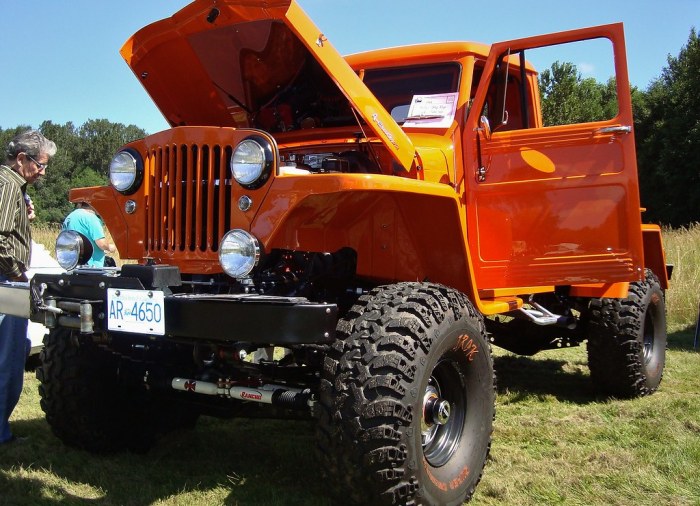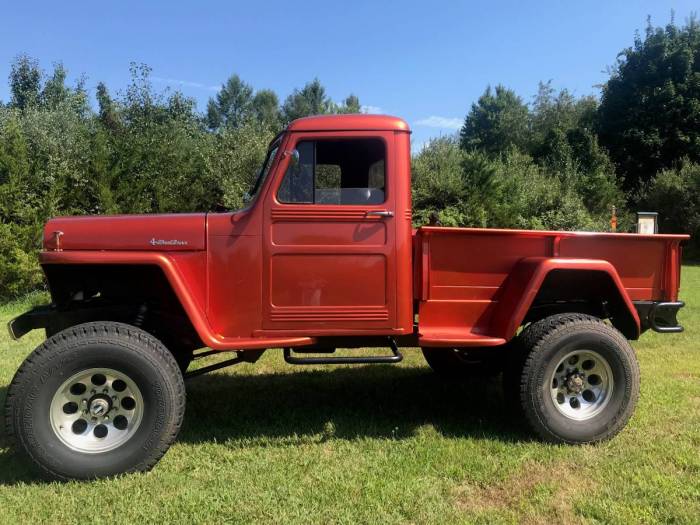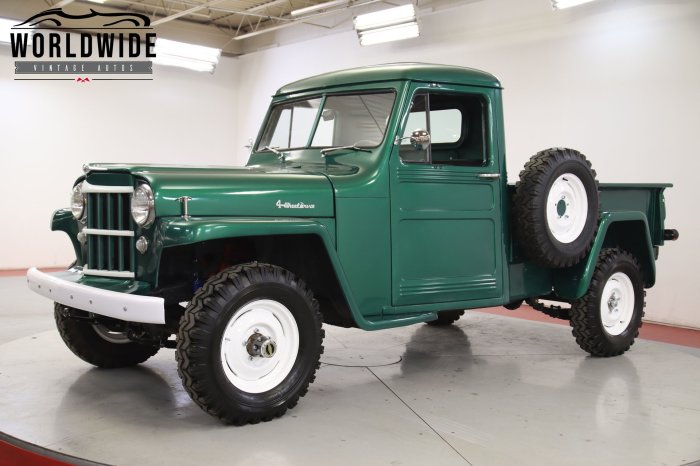The 1948 Willys Pickup, a rugged and versatile vehicle, emerged from the ashes of World War II to become a symbol of American ingenuity and resourcefulness. This pickup truck, built by the renowned Willys-Overland Motors company, was a testament to the company’s wartime experience and its commitment to producing durable and reliable vehicles for the civilian market.
The 1948 Willys Pickup was more than just a truck; it was a testament to the spirit of innovation that defined the post-war era.
The Willys Pickup’s design, rooted in the legendary “Jeep” heritage, offered a blend of ruggedness and practicality. It featured a sturdy frame, a powerful engine, and a versatile bed, making it ideal for a wide range of tasks, from hauling goods to transporting families.
The truck’s compact size and maneuverability made it a favorite among farmers, ranchers, and businesses across the country.
History and Background

The 1948 Willys Pickup, a stalwart of the post-war American automotive landscape, emerged from a period of significant change and adaptation. The Willys-Overland Motors company, having played a crucial role in the war effort by manufacturing the iconic Jeep, was now navigating the transition to a peacetime economy.
Role of Willys-Overland Motors
The war had significantly impacted the automotive industry, with manufacturers shifting production to military vehicles. Willys-Overland, known for its robust and reliable Jeeps, found itself well-positioned to capitalize on the demand for durable and versatile vehicles in the post-war era.
The company’s expertise in building off-road vehicles, combined with the growing popularity of pickup trucks, led to the development of the Willys Pickup.
Key Features and Specifications
The 1948 Willys Pickup was a compact and rugged truck designed for both work and leisure. Its key features included:
- A powerful four-cylinder engine, the “Go Devil” L134, known for its durability and fuel efficiency.
- A robust frame and suspension system, capable of handling heavy loads and rough terrain.
- A simple and straightforward design, emphasizing practicality and ease of maintenance.
- A versatile cargo bed, adaptable to various hauling needs.
The 1948 Willys Pickup’s specifications reflected its focus on utility and affordability:
| Specification | Value |
|---|---|
| Engine | 4-cylinder, L134 “Go Devil” |
| Horsepower | 60 hp |
| Transmission | 3-speed manual |
| Wheelbase | 102 inches |
| Payload capacity | 1,500 lbs |
Production and Sales Figures
The 1948 Willys Pickup was a commercial success, capturing a significant share of the post-war pickup truck market. The company produced over 40,000 units of the 1948 Willys Pickup, a testament to its popularity among farmers, ranchers, and businesses seeking a reliable and affordable workhorse.
Design and Engineering

The 1948 Willys Pickup, born out of the success of the iconic Jeep, was a vehicle designed for practicality and durability. It aimed to provide a reliable and robust workhorse for farmers, ranchers, and businesses, capitalizing on the proven capabilities of its military predecessor.
The Legacy of the “Jeep”
The Willys Pickup inherited the rugged and versatile design philosophy of the legendary Jeep, a vehicle that had proven its mettle in the harsh conditions of World War II. This heritage was evident in the truck’s sturdy frame, simple yet effective mechanical components, and a focus on off-road capability.
The Jeep’s reputation for reliability and durability was a significant selling point for the Willys Pickup, assuring potential buyers of its strength and resilience.
Key Engineering Innovations
The 1948 Willys Pickup introduced several innovative engineering features for its time. These included:
- Independent front suspension:This system, borrowed from the Jeep, provided a smoother ride and better handling compared to the solid axles commonly found in trucks of the era. The independent front suspension allowed each wheel to move independently, improving traction and stability, especially on rough terrain.
- All-wheel drive:While not standard equipment, the option for four-wheel drive was a significant feature, enhancing the truck’s off-road capabilities. This was a feature that appealed to buyers who needed a vehicle that could handle challenging terrain and weather conditions.
- Lightweight construction:The Willys Pickup was built using a lightweight steel frame, which contributed to its fuel efficiency and maneuverability. This was a significant advantage over heavier trucks of the time, allowing for better performance and lower operating costs.
Comparison to Contemporary Trucks
Compared to other trucks available in 1948, the Willys Pickup stood out for its compact size, maneuverability, and off-road capability. While other trucks were often larger and more powerful, the Willys Pickup offered a more nimble and versatile option for various tasks.
Its lightweight construction and independent front suspension made it more agile and fuel-efficient, while its four-wheel drive option provided an advantage in challenging conditions.
Impact and Legacy: 1948 Willys Pickup

The 1948 Willys Pickup, a product of the post-World War II era, played a significant role in shaping the automotive landscape and left an enduring legacy that continues to influence pickup truck design and culture today. Its impact extended beyond its immediate commercial success, leaving a mark on various industries and sectors.
Impact on the Automotive Industry, 1948 Willys Pickup
The 1948 Willys Pickup’s impact on the automotive industry was multifaceted. Its compact size and rugged construction made it a popular choice for both personal and commercial use, contributing to the growing popularity of pickup trucks as versatile vehicles. The truck’s affordability and fuel efficiency also appealed to a wide range of consumers, particularly in the post-war era.
The success of the Willys Pickup helped pave the way for the development of other compact pickup trucks, influencing the design and features of future models.
Role in Shaping Pickup Truck Development
The 1948 Willys Pickup’s design and engineering innovations significantly influenced the development of pickup trucks. Its compact size, light weight, and efficient four-cylinder engine established a template for future compact pickups. Its innovative features, such as its independent front suspension and four-wheel drive option, set a precedent for future truck design and functionality.
The Willys Pickup’s ruggedness and versatility established a standard for pickup trucks as durable and capable vehicles.
Use in Various Industries and Sectors
The 1948 Willys Pickup found applications across a wide range of industries and sectors. Its versatility and ruggedness made it ideal for a variety of tasks, from farming and construction to delivery and transportation.
- Farmers relied on its hauling capacity for transporting crops and livestock.
- Construction workers used its durability for hauling materials and equipment.
- Delivery companies utilized its compact size for navigating urban environments.
- Utility companies employed its four-wheel drive capability for accessing remote areas.
The truck’s adaptability made it a valuable asset in various sectors, contributing to the growth and development of these industries.
Lasting Legacy and Cultural Significance
The 1948 Willys Pickup left a lasting legacy in the automotive world and popular culture. Its distinctive design and rugged reputation continue to be celebrated by enthusiasts and collectors. The truck’s iconic status is evident in its enduring popularity as a restoration project and its presence in numerous films and television shows.
The Willys Pickup’s legacy as a symbol of American ingenuity and post-war prosperity continues to resonate today, solidifying its place in automotive history.
Notable Features

The 1948 Willys Pickup, though simple in design, boasted several features that made it a workhorse for its time. Its rugged construction, compact size, and versatile capabilities made it a popular choice for farmers, ranchers, and businesses.
The 1948 Willys Pickup was a rugged workhorse, known for its simple design and ability to handle tough jobs. It shared some of its DNA with the iconic 1947 Willys CJ2A , a Jeep that became synonymous with off-road adventure.
While the CJ2A was built for the battlefield and the outdoors, the 1948 Willys Pickup was designed for hauling and getting the job done, making it a popular choice for farmers, ranchers, and businesses across the country.
Key Features
The following table highlights some of the most notable features of the 1948 Willys Pickup:
| Feature | Description | Significance |
|---|---|---|
| Four-wheel drive | The Willys Pickup was available with a four-wheel drive system, providing superior traction and off-road capability. | This feature made the truck ideal for challenging terrain and weather conditions, increasing its versatility and utility. |
| Solid axles | Both the front and rear axles were solid, offering durability and strength for heavy-duty applications. | This design ensured the truck could handle heavy loads and rough roads without compromising its structural integrity. |
| Leaf spring suspension | The truck featured a leaf spring suspension system, providing a simple and reliable design for a comfortable ride. | Leaf springs were known for their durability and ability to handle heavy loads, making them suitable for a work truck. |
| Goodyear tires | The 1948 Willys Pickup came equipped with Goodyear tires, known for their durability and performance. | These tires provided good traction and a long lifespan, contributing to the truck’s overall reliability and dependability. |
| 6-cylinder engine | The Willys Pickup was powered by a 134 cubic inch, 6-cylinder engine, offering a balance of power and fuel efficiency. | This engine provided sufficient power for most tasks while maintaining reasonable fuel consumption, making it practical for everyday use. |
| 3-speed manual transmission | The truck featured a 3-speed manual transmission, offering simple operation and reliable shifting. | This transmission provided the driver with control over gear selection, allowing them to optimize performance for various driving conditions. |
| Flatbed cargo bed | The Willys Pickup had a flatbed cargo bed, providing a versatile platform for hauling various goods. | This design offered flexibility in loading and unloading cargo, making the truck suitable for a wide range of applications. |
Unique Design Elements
The 1948 Willys Pickup featured several unique design elements that contributed to its distinctive look and functionality. The truck’s compact size and short wheelbase made it maneuverable in tight spaces, while its high ground clearance allowed it to navigate uneven terrain with ease.
The 1948 Willys Pickup was a workhorse, built to handle tough jobs. While it was known for its utility, the same year saw the birth of another legend: the 1948 Willys Wagoneer. This four-wheel drive vehicle was a game-changer for off-roading, and it paved the way for the modern SUV.
While the Pickup focused on work, the Wagoneer brought adventure to the forefront, showing that a Willys could be more than just a tool.
The distinctive grille, with its vertical bars and Willys emblem, became a recognizable feature of the brand. The truck’s bodywork was simple and functional, with minimal ornamentation, reflecting the utilitarian nature of the vehicle.
Functionality and Purpose
Each component of the 1948 Willys Pickup was designed with a specific purpose in mind, contributing to the truck’s overall functionality.The four-wheel drive system provided superior traction and off-road capability, making the truck ideal for farmers, ranchers, and construction workers.
The solid axles and leaf spring suspension ensured durability and strength, allowing the truck to handle heavy loads and rough terrain. The flatbed cargo bed provided a versatile platform for hauling various goods, while the 6-cylinder engine offered a balance of power and fuel efficiency.
Comparison to Other Vehicles
The 1948 Willys Pickup stood out from other vehicles of the same era with its rugged construction, compact size, and versatile capabilities. Compared to other trucks of the time, the Willys Pickup was known for its off-road performance, fuel efficiency, and affordability.While other manufacturers focused on larger, more powerful trucks, Willys targeted a niche market with its compact and versatile pickup.
The Willys Pickup offered a practical and affordable solution for farmers, ranchers, and businesses who needed a reliable workhorse for various tasks.
Restoration and Preservation

Bringing a 1948 Willys Pickup back to its former glory is a labor of love that requires dedication, patience, and a good understanding of the vehicle’s history and mechanics. This guide will provide you with a comprehensive roadmap for restoring your classic Willys, from identifying key components to sourcing parts and navigating the challenges along the way.
Identifying Key Components for Restoration
Restoring a 1948 Willys Pickup involves addressing various components, each contributing to the vehicle’s overall condition and functionality. Here are some of the key areas that require attention:
- Body and Frame:The body and frame are the foundation of the vehicle, and their condition will significantly impact the restoration process. Examine for rust, dents, and damage, and plan for repairs or replacements as needed.
- Engine and Drivetrain:The engine and drivetrain are the heart of the vehicle, responsible for power and movement. Assess the condition of the engine, transmission, and axles, and consider a complete rebuild or replacement if necessary.
- Electrical System:The electrical system powers various components, including lights, ignition, and gauges. Inspect the wiring, battery, and alternator, and replace any damaged or faulty parts.
- Interior:The interior, including the seats, dashboard, and upholstery, contributes to the vehicle’s comfort and aesthetic appeal. Evaluate the condition of the interior components and consider reupholstery or replacement as needed.
- Suspension and Brakes:The suspension and brakes ensure a smooth and safe ride. Inspect the suspension components, brakes, and steering, and replace any worn or damaged parts.
Sourcing Original Parts and Replacement Components
Finding original parts for a 1948 Willys Pickup can be a challenge, but with perseverance and the right resources, you can find what you need.
- Online Marketplaces:Websites like eBay, Craigslist, and specialized online forums dedicated to classic cars offer a vast selection of original and reproduction parts.
- Classic Car Parts Suppliers:Many companies specialize in providing parts for classic vehicles, including Willys Jeeps. These suppliers often carry a wide range of original and aftermarket parts.
- Willys Jeep Clubs:Joining a Willys Jeep club can connect you with fellow enthusiasts who may have access to parts or know where to find them.
- Junkyards and Salvage Yards:These locations can be treasure troves for original parts, but you’ll need to be patient and persistent to find what you’re looking for.
Challenges and Rewards of Restoring a 1948 Willys Pickup
Restoring a 1948 Willys Pickup is a challenging but rewarding experience.
- Time and Effort:Restoration can be a time-consuming and labor-intensive process, requiring significant dedication and effort.
- Cost:Depending on the scope of the restoration, costs can range from moderate to substantial, especially when sourcing original parts.
- Finding Expertise:Certain restoration tasks may require specialized knowledge or skills, which may necessitate seeking professional help.
- Sense of Accomplishment:The satisfaction of bringing a classic vehicle back to life is immeasurable, providing a sense of accomplishment and pride in your work.
- Preserving History:Restoring a 1948 Willys Pickup helps preserve a piece of automotive history and ensures that this iconic vehicle continues to be enjoyed for generations to come.
Last Word

The 1948 Willys Pickup left an indelible mark on the automotive industry, paving the way for the modern pickup truck. Its legacy lives on in the countless classic vehicles that grace roads and car shows today. For enthusiasts and collectors, the 1948 Willys Pickup represents a piece of American history, a testament to a time when innovation and practicality went hand-in-hand.